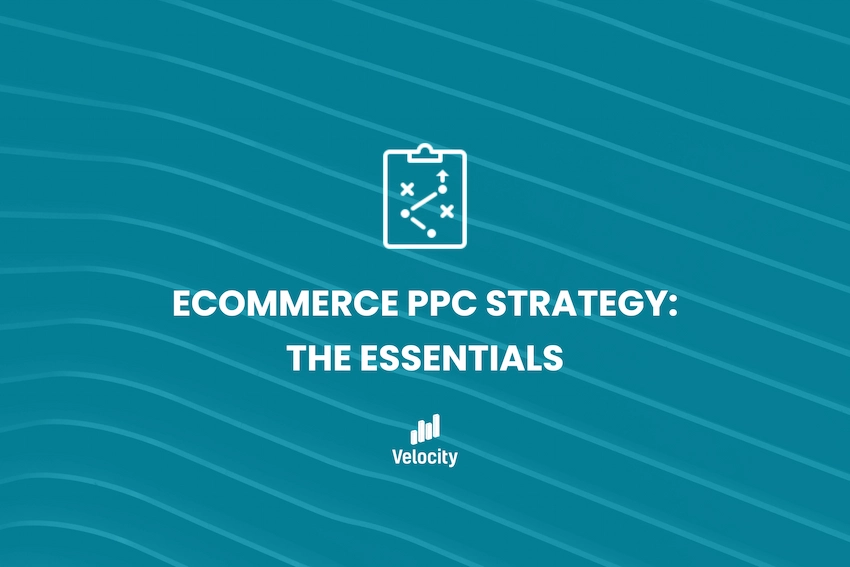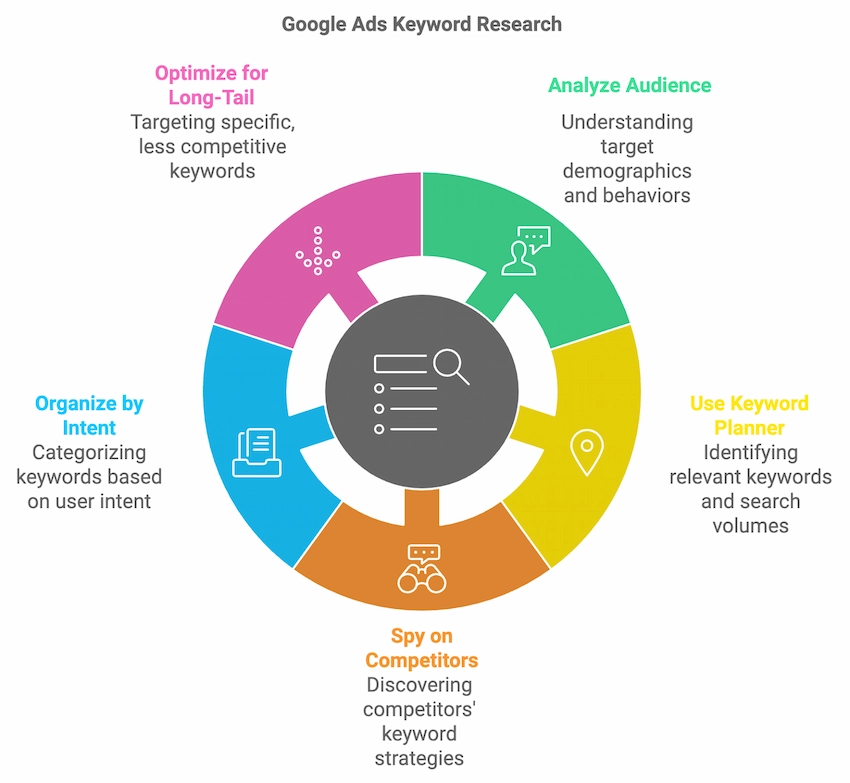eCommerce PPC Strategy: The Essentials

PPC is a lucrative, but tough channel for eCommerce businesses. Paid search or social ads are the most effective way to get your products in front of large audiences and scale profitably – but visibility remains furiously competitive.
Whilst it’s tempting (and often very useful!) to throw yourself down the rabbit hole of ‘latest PPC trends’ and thought leadership blogs to try and get ahead of your competitors, there’s something to be said for making sure you’re still getting the basics right.
So, whether you’re new to this or just need a quick refresher, here are our 6 fundamental ‘must-haves’ for a stellar eCommerce PPC strategy.
6 Successful eCommerce PPC Strategies
1. Spend time building a strong keyword strategy
If you want to maximize the revenues you generate via PPC, a killer keyword strategy is a must, especially in a sector as competitive as eCommerce. Dedicate as much time to research and optimization of your keyword strategy as you can – you’ll reap the returns later.
You can read our complete guide to keyword strategy here – but here’s a quick summary of how to approach it:
- Analyze your audience to understand their behaviors. Create detailed buyer personas and start building lists of keywords that align with their needs and interests.
- Use keyword tools to fine-tune your list. For example, when you enter an initial keyword into Google Ads, the tool will generate a list of related keywords along with search volume, competition, and average cost per click (CPC).
- Find a balance between traffic and cost. Ideally, opt for a range of keywords – some more competitive, some less so
- Spy on your competitors’ keywords: why should they have all the fun? Tools like Ahrefs and SEMRush provide some insight into what your competitors are bidding on, which helps you identify gaps in your own keyword strategy.
- Organize your keywords by intent: which keywords are most likely to be used by purchase-ready customers, and which by those still considering their decision? Create separate groups for customers at each stage of the buying funnel.
- Optimize for long-tail keywords: long-tail keywords often have less competition but higher purchase intent, making them a super cost effective way of driving traffic.

What types of keywords work well for eCommerce businesses?
- Product names: include exact product names from your inventory for purchase-ready audiences
- Product features: include key features of your product, for example “waterproof”, “foldaway”, “9-carat”
- Brand names: include your brand name (and potentially your competitor names) to increase brand awareness and piggyback off competitor audiences.
- Long-tail keywords: longer phrases offer lower search volume but higher conversion potential
2. Know what you want from each platform
Popular PPC platforms for eCommerce include Google Ads, Meta Ads and Microsoft/Bing Ads. Meta Ads gives you access to both Facebook and Instagram, while YouTube ads can be run directly from Google’s Ad interface.
Each PPC platform has their own strengths, and knowing how to leverage these can make a huge difference to your campaign. Some work better from a sales point of view, some excel at promoting brand awareness, some drive better results for B2B…you get the gist.
Knowing what you want from each platform is vital for assigning your ad budget wisely, tracking the right metrics, and getting the best return possible on your ad spend.
For example, eCommerce businesses might find that Google Ads generates the most revenue, thanks to its ability to target actively searching, ready to buy audiences. Equally, they might also want to leverage Facebook Ads as a brand awareness tool thanks to its passive user reach.
Which PPC platforms are best for eCommerce businesses?
- Google Ads: the world’s most popular PPC network, with a 28% market share. Thanks to the unparalleled visibility, purchase ready audiences, and targeting options it offers advertisers, Google Ads is the safest bet for boosting sales, fast.
- Bing Ads: very popular with specific demographics, such as the over 50s – worth a look if your target audience overlaps.
- Meta Ads: the world’s largest social media network, covering Facebook, Instagram, and Messenger. Thanks to a wide range of targeting options, ads can drive a decent amount of revenue – but they really excel at brand awareness and audience building.
- TikTok Ads: keen to reach younger audiences? TikTok ads is a relative newcomer to the scene, but can yield solid results for advertisers who are savvy enough.
3. Segment your search campaigns appropriately
Dividing your audience into several, smaller sub-audiences allows you to target them with the most relevant ads possible, which increases the likelihood of catching their attention and making a sale.
This is called ‘segmentation’. You can segment your audience across many different lines:
- Geography: based on where your audience lives, e.g., US – gold jewelry, UK – gold jewelry
- Product category: based on the type of product you are selling, e.g., US – gold jewelry, US – silver jewelry
- Bid strategy: based on the bid strategy you’re using to win ad space, e.g., US – gold jewelry – maximize conversions, US – gold jewelry – target ROAS
- Keyword match type: based on how closely you want users’ search queries to match your chosen keyword for your ad to appear – broad, exact or phrase
- Niche category: based on the sector you’re selling into, e.g., US – homeware, US – beauty
You might use multiple, overlapping segments to build a campaign with the perfect audience. For example, you could run a region-specific campaign with different product lines as ad groups, or do the same state by state.
Our top tip: there is no universally perfect level of campaign segmentation – everything depends on your budget, advertising goals, and target audience. That said, try to maintain distinctions between campaigns and segments so you’re clear on their purpose. For example, keeping your campaigns split into brand and non-brand themes.
4. Optimize your bidding strategy with intelligent tools
It’s 2025. There’s absolutely no need for you or your team to spend your time bidding on keywords manually – especially in eCommerce, where you’ll typically need higher volumes of ads to cut through the noise.
All major PPC platforms now offer smart bidding tools, allowing you to take advantage of fully automated bidding (automates bidding based on a given budget to best meet your campaign goals).
What type of bidding should I use?
You’re not short of options here. Using smart, machine-learning based tools, you can choose to:
- Maximize clicks: optimize your bids to get the most clicks for your budget
- Maximize conversions: optimize your bids to get the most conversions for your budget
- Maximize conversion value: optimize to get the most conversion value
- Target ROAS: optimize your bids for a target return revenue
- Target CPA: optimize your bids around a target cost per acquisition
- Target impression share: optimize bids to claim a certain % of impression share
Running a product or sales focused campaign? Use maximize conversions, maximize conversion value or ROAS-based bidding strategies to make sure your ads are bringing in that revenue.
It all comes down to your goals. You can even segment your campaigns based on bidding strategy, so that you’re clear on the purpose of different ads and channels.
5. Use A/B testing to optimize your ad creative
Unsure about the most effective video ad, landing page copy, or ad headline? Show 50% of your audience one option and 50% of your audience the other and see which performs the best in terms of click-throughs or conversions.
The beauty of A/B testing is that it gives you highly-relevant campaign insights whilst helping you pin down your audience’s broader preferences to feed back into branding and design work.
For example, over time you may notice that your audience usually responds better to a particular tone of voice or writing style – you can then start to incorporate this from the get-go to maximize your campaign’s success.
For A/B testing to work effectively:
- Limit the scope: test one aspect of your ad creative at a time. If you test two ads with different headlines, body copy, and images, how can you tell which of these is driving different user behavior?
- Test two strong versions: testing one variant against another you know won’t perform as well is of limited use.
- Measure against a control: if you’re optimizing an existing asset (for example a landing page), compare the performance of your new variants with the one you’re updating. You should see look for an increase in performance – if not, it’s back to the drawing board!
6. Get expert advice to level up your PPC
Our final tip for a solid PPC strategy? Know what you can do in-house, and know when to look for an ecommerce ads agency.
Without a strong in-house team dedicated to PPC and PPC only, you’re likely missing out on opportunities to seriously level up your paid advertising game. Not because your general marketers aren’t talented – but because they don’t have the time to invest in a complex and constantly changing ads platform.
For less than the price of one full-time PPC specialist, you could onboard an agency like Velocity, whose entire team is dedicated to driving PPC revenue. And, your business benefits from this expertise immediately – no drawn out search for the perfect in-house hire.
Read how we increased the yearly business revenues of this vintage retailer by 25%
…or get in touch for a chat. We’d love to see what we could bring to your eCommerce business.
